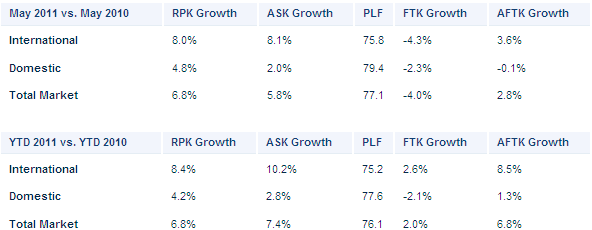Demand grows in May – good news on volumes, but risks remain
- Like
- Digg
- Del
- Tumblr
- VKontakte
- Buffer
- Love This
- Odnoklassniki
- Meneame
- Blogger
- Amazon
- Yahoo Mail
- Gmail
- AOL
- Newsvine
- HackerNews
- Evernote
- MySpace
- Mail.ru
- Viadeo
- Line
- Comments
- Yummly
- SMS
- Viber
- Telegram
- Subscribe
- Skype
- Facebook Messenger
- Kakao
- LiveJournal
- Yammer
- Edgar
- Fintel
- Mix
- Instapaper
- Copy Link
Posted: 30 June 2011 | IATA | No comments yet
IATA announced traffic results for May which showed a 6.8% increase in passenger traffic over May 2010…


The International Air Transport Association (IATA) announced traffic results for May which showed a 6.8% increase in passenger traffic over May 2010. This is 4% higher than the beginning of the year. Freight traffic showed a drop of 4% against the post-recession peak of the re-stocking cycle in May 2010. However, recent months show a renewed upward trend with freight volumes 2% higher than the start of the year.


“We saw positive developments for the air transport volumes in May. International passenger load factors rebounded by 0.8 percentage points to 75.8%. Freight volumes improved by 1.2% over April and passenger volumes were up by 1.8%. These will help to alleviate some of the pressure on profits from continued high fuel prices,” said Giovanni Bisignani, IATA’s Director General and CEO.
“But there are risks associated with political unrest in the Middle East and the European currency crisis. We still expect the industry to make $4 billion this year. That is a pathetic 0.7% margin and another shock could alter the industry’s fortunes dramatically. It’s another tough year for a very fragile industry,” said Bisignani.
International Passenger Markets by Region
- African airlines’ international traffic increased 1.1% over the previous year. Travel markets to the region had been depressed by the impact of political unrest in Egypt and Tunisia. Flights to these two destinations are still about 20% down. However a significant 2.2 percentage point improvement in the load factor for the month does show initial signs of improvement.
- Asia-Pacific carriers recorded an expansion of 4.7%, considerably below the global average of 8.0%. This is due to continuing weakness in the post-earthquake/tsunami Japanese market. Compared to May 2010, capacity expanded 5.0% and the load factor fell slightly to 73.4%.
- European carriers’ traffic expanded by 10.9%, boosted by increased northern European economic activity and a weaker Euro encouraging trade and inbound travel. Capacity expanded by 10.6%, second only to Latin America, and the load factor strengthened to 77.7%.
- Latin American carriers saw the fastest international growth, up 21.3% compared to May 2010, and the fastest capacity expansion (15.2%). This is a consequence of strong economic growth and increased travel and trade flows to North America and across the Pacific. The load factor is just above the industry average at 76.0%.
- Middle East carriers grew international traffic by 7.8% over May 2010, slightly below a 9.6% capacity expansion that saw load factors slip to 70.8%. While political unrest continues to have a dramatic impact on several of the region’s smaller markets, the overall impact on the region’s carriers is very limited.
- North American carriers have cut capacity for two consecutive months (-0.4% in April and -0.5% in May). Year-on-year, traffic is up 4.5% and capacity increased by 5.5%. This cautious approach to capacity expansion resulted in the highest load factor (81.8%) among the major regions.
Domestic Passenger Markets by Region
- Japanese domestic demand was 29.9% below May 2010 while capacity has been adjusted downwards by 20.8%. Total volumes in May were 4.4% higher than in April, showing the initial signs of recovery from the earthquake and tsunami. But the low 54.7% load factor indicates the continuing mismatch between supply and demand.
- Brazil remains volatile but demand is up 21.6% on May 2010 while capacity was 7.2% higher. The volatility of the market is evident in a 65.7% load factor even with the demand outstripping capacity by such a wide margin.
- In China, demand was 10.4% higher than the previous May. A capacity expansion of just 3.3% resulted in load factors of 81.5%. While this is still robust growth, it is a major ramping down from the 14.6% recorded in 2010— reflecting tighter economic policies.
- India domestic demand was 13.8% above previous-year levels against a capacity expansion 19.9%. The load factor of 78.3% is consistent with the global average of 79.4%.
- The mature United States domestic demand grew by 4.0% compared to the previous May. Against a 1.5% increase in capacity, load factors were pushed to 84.6%–the highest among domestic markets surveyed.
Freight (Domestic + International)
Air freight markets showed a 4.0% decline in May. This is skewed as a result of the May 2010 peak for of the post-recession restocking cycle. Since the beginning of the year, freight volumes have increased by a modest 2.0%. This is lower than the 5.5% IATA forecast for 2011. While the continued expansion of world trade at around 6% annually could lend support to accelerated freight growth in the second half of 2011, the performance so far this year has been lower than expected. Carriers in all regions except Latin America (up 1.5%) and the Middle East (+8.1%) saw air freight declines compared to May 2010. The largest fall was for Asia-Pacific carriers with a 9.2% drop showing the impact of disrupted supply chains in Japan and tighter economic policies in China. Declines by African carriers (down 7.8%) reflected the disruption in Egypt and Tunisia. European and North American carriers had modest falls of 2.2% and 1.4% respectively.













